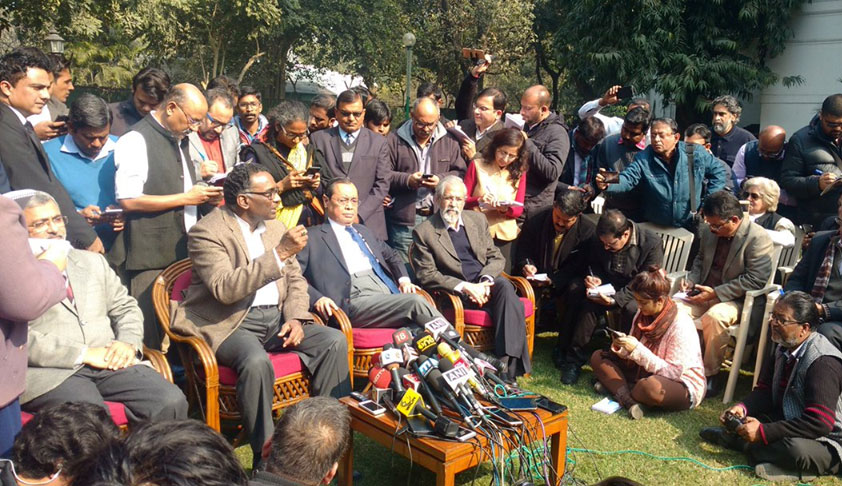Apex Saga – A Sublime Appeal And Not A Mundane Mutiny
Advocate S Sanal Kumar
19 Jan 2018 3:33 PM GMT
An inevitable dissent from inside...!!! The system undergoing tremendous in-house pressure has ultimately showed its cracks to the world. The unprecedented confession and the appeal to the nation by judges underline one thing that it is not the Constitution, but the People of India that is sovereign. The Constitution is only an instrument which the People of India have adopted,...
An inevitable dissent from inside...!!! The system undergoing tremendous in-house pressure has ultimately showed its cracks to the world. The unprecedented confession and the appeal to the nation by judges underline one thing that it is not the Constitution, but the People of India that is sovereign. The Constitution is only an instrument which the People of India have adopted, enacted and given unto themselves for their governance on the 26th of November 1949. People are Supreme – the judge’s appeal reinforces the ultimate truth in a constitutional democracy.
The framers of the Constitution envisaged a free, independent and impartial judiciary. Enough safeguards and sheaths were built into the Constitution to enamour the judiciary from outward onslaught and pressures. The men appointed to man the higher judiciary post Independence were venerated souls who imbibed the social, political and cultural values of freedom struggle era. As expected, they delivered what was desired from them by the makers of the Constitution. Judges with outstanding legal acumen, perspicacity and social commitment made the Constitution an organic document. Flesh and blood was given to the constitutional skeleton by their interpretations paving way for the emergence of constitutional philosophy in India. Keeping pace with the international standards and values of human rights jurisprudence, our Constitution also slowly evolved and kept abreast with jurisprudence of civilized nations. But by the developments in the late seventies, with the initially benevolent despotism of Indira Gandhi turning malefic, the degeneration in the judicial system started. With the epoch making Kesavanand Bharathi case where the constitutional subterfuge of ‘basic structure doctrine’ was evolved, the executive showed signs of hegemony over judiciary. Though the Parliament’s power of amendment of the Constitution was upheld with rider, the Judges with the minority opinion faced executive’s wrath. When Justice AN Ray was appointed as the Chief Justice superseding three senior judges, the executive inroad into independence of judiciary came to the fore. The resignation of the three judges was probably the first revolt by judges. The celebrated ‘Habeas Corpus Case’ also had its fallout on judiciary with dissenting judge HR Khanna losing the coveted post of Chief Justice of India. When the majority judges ruled in favour of the executive stand of freezing fundamental rights during Emergency, the standalone stance of Justice Khanna holding contrary view dearly cost him. Justice MH Beg was chosen to the stewardship of judiciary, with Khanna resigning in protest. The post-Emergency period witnessed some damage-control exercise by the Morarji Desai government. The stripped-off constitutional provisions were livened up with the 44th Amendment to the Constitution by the Janata government. But by then, the power dynamics between executive and judiciary underwent a massive change with executive’s penchant to control judiciary became more manifested before the nation. Appointment of judges in the higher judiciary was handy weapon for the executive to hold the leash over judiciary.
The 1st judge’s appointment case/transfer case (SP Gupta v Union of India) came to be pronounced in the aftermath of Indira Gandhi returning to power with two-third majority in 1980. The constitutional requirement of consultation with the Chief Justice of India in the matter of appointment of judges in the Supreme Court and high courts was construed for the first time. The gainer was executive with the Supreme Court deciding in favour of executive’s primacy in the matter of appointment. The browbeating majority of Indira Gandhi in the Parliament was no less lenient to anyone and things had to follow the path of executive. The judicially proclaimed primacy of executive in the affairs of appointment continued till 1993. The assertive executive became weak from 1989 with Independent India witnessing a minority government under VP Singh. In India, political stability was fast eroding during the early nineties. The minority government of Narasimha Rao plunged into many controversies like the Jharkhand Mukti Morcha Case and its political fallouts. Due to political defections, political instability erupted in many states like Karnataka which necessitated interpretation of anti-defection laws by judiciary. With instances of political leaders enmeshed in criminal cases coupled with their urge to have favourable interpretation on defection laws, leaders across the political spectrum started kneeling down before Judiciary. The atmosphere was ripe for Judiciary to usurp the power of appointment and court’s timely assertion came out by way of the second judges case (Supreme Court Advocate-on-Record Association v Union of India) by the proclamation of judicial primacy. The concept of consultation with Chief Justice was construed to be concurrence. For the executive, the nineties spelled doom. By mid-nineties, prominent leaders like LK Advani, VC Sukhla of various political parties were in the dock with Jain Hawala case. Narasimha Rao had to appear before a Court of Magistrate as an accused in the Lakhu Bhai Pathak case. Between 1995 and 1999, India had to face three midterm polls with fractured verdict resulting in paralytic polity. Coincidentally, the third judge’s appointment case (In Re Special Reference) surfaced by way of Presidential reference. The already laid foundation for collegium system for appointment of judge’s sprang up fully with the Supreme Court deciding the modalities of appointment and its full arrogation to itself the power of appointment. The extra constitutional mechanism which the People of India have never given unto themselves in their Constitution came into being with its full apparition. A constitutional calamity of colossal magnitude started trampling up on democracy like a demon.
When the collegium system stooped down to an abysmally low level in terms of its performance, firstly the lawmen raised their eyebrows. The higher judiciary turned into a hereditary office with little opportunity to non-consanguine brilliants. When India witnessed a single party rule after 25 years in 2014, the executive became emboldened to enact the Constitution Amendment for establishing National Judicial Appointment Commission. The Constitution Amendment was carried through a near unanimity with almost all State Legislatures ratifying it. The Constitution Amendment was as good as Constituent Assembly sitting again and filling up a vacuum in the Constitution. The unique Constitution Amendment, expressing the will of the People of India in unanimity, was lightly crushed to pieces by the apex court.
Post NJAC, the nation witnessed the biggest fraud on the Constitution. After declaring the law as unconstitutional, the executive and judiciary started sitting together to frame rules for appointment of judges under the caption ‘Memorandum of Procedure’. Once the law is declared void by the court, no jurisprudential principles say that Parliament cannot legislate on the subject anymore by remedying the flaws in the void law. Instead of leaving the matter to Parliament, the apex court assumed role of Parliament. The process of appointment is being reduced to a matter of sharing of power of appointment on prefixed terms by executive and judiciary. Parliament is kept at bay in the process. Parliament, symbolising the voice of people, has no say in the vital function. The letter released by the judges to the press reveals that the issue of finalization of MOP being assigned to a smaller bench excluding the senior judges was a major bone of contention, apart from some other matters of flip-flops on administrative front. Among the innumerable ambitions of executive, predominant leverage in appointment of judges is one of them is no secret now.
Forget about the constitutional propriety of judges holding a press conference. Revolution knows no convention or protocol. Look at the substance. A contagious malady afflicting the system is spoken to the nation by the limbs of the judicial body. The issue is not simply ‘mastering the roster’ or ‘twisting the roster’. But it is concerning who is ‘ruling the roost’ - executive or extra-executive? Time is opportune for the political spectrum to assert parliamentary supremacy. The appeal of the four judges is to the people – focused to the Parliament. There exists a crisis in the judiciary. It is an irony that in the name of ‘basic structure’, the judiciary struck down an unparalleled democratic wish in the form of NJAC. When independence of judiciary was made part of ‘basic structure’, the now aghast apex court had not given democracy the place of even a pillar stone of a fencing. Now it understands that it is not the Constitution or Supreme Court that is supreme, but the People of India, who have adopted, enacted and given unto themselves the Constitution, is the Sovereign and the Supreme. Now the apex court’s appeal is in the people’s court. Revolution knows no convention or protocol. A big salute to democracy.
 Adv. S.Sanal Kumar is a Lawyer practicing at High Court of Kerala
Adv. S.Sanal Kumar is a Lawyer practicing at High Court of Kerala[Views are personal]


